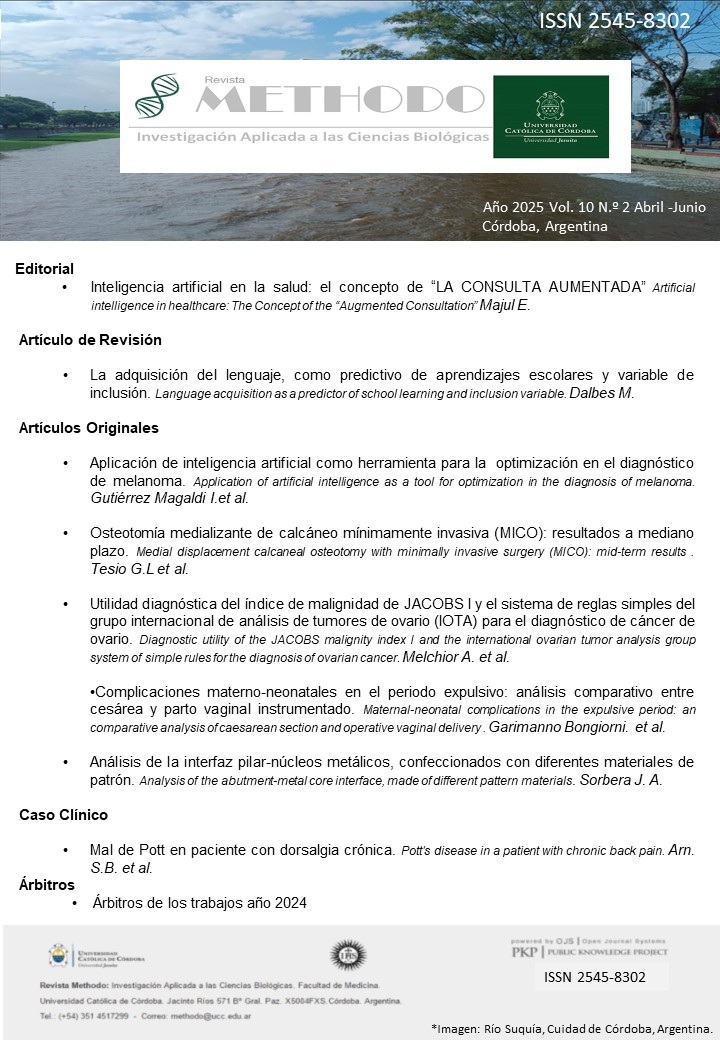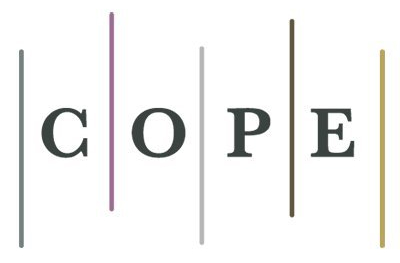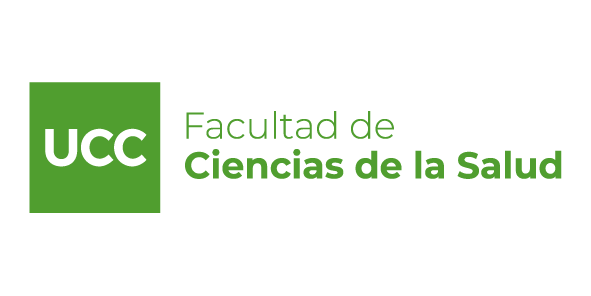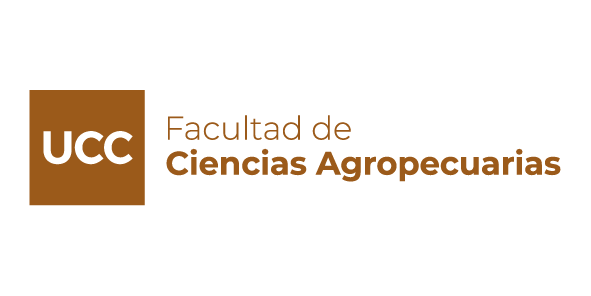Medial displacement calcaneal osteotomy with minimally invasive surgery (MICO): mid-term results
DOI:
https://doi.org/10.22529/me.2025.10(2)04Keywords:
Calcaneal Osteotomy, Minimally Invasive Surgery, Progressive Collapsing Foot DeformityAbstract
INTRODUCTION: Minimally invasive calcaneal osteotomies (MICO), with medial displacement, are atechnique increasingly used to correct foot deformities with progressive collapse, a pathology that we previously used to refer to as flatfoot valgus. The rise of the percutaneous and minimally invasive technique is mainly due to the excellent functional results and the low rate of complications.
OBJECTIVE: To describe the medium-term results of MICO with medial displacement, as a single or associated gesture, in the treatment of flexible foot deformities with progressive collapse. Compare pre- and postsurgical radiographic parameters and establish the frequency of complications related to the minimally invasive approach.
MATERIAL AND METHOD: An observational, retrospective and analytical study was carried out in which the data of patients who underwent surgery with MICO with medial sliding were analyzed, as a single or associated gesture, in the treatment of flexible foot deformities with progressive collapse, between January 2019. and January 2022. The pre-operative radiographic parameters analyzed were the Meary line and the Moreau and Costa Bertani angle. The postoperative radiographic parameters examined were, in addition to the mentioned angles, the degree of medial displacement of the posterior tuberosity of the calcaneus. Jointly, the time of exposure to X-rays, the operative time isolated from the osteotomy and the complications related to the minimally invasive approach were recorded. Statistical analysis: The data is shown with descriptive statistics. The comparison of pre- and postoperative Meary angles was performed with the paired Wilcoxon test, while the comparison of pre- and postoperative Moreau and Costa Bertani angles was performed with the paired t test. A p value ≤ 0.05 was considered significant.
RESULTS: 29 feet from 28 patients were analyzed. Of them, 18 (64.29%) patients were female and had a mean (standard deviation - SD) age of 42.57 (10.92) years. An associated procedure was performed in 27 of 29 (93.1%) feet. The minimum follow-up was 24 months. The median (interquartile range - IQR) of the preoperative Meary angle was 8.50 (3) degrees, while that of the postoperative angle was 1 (1) degrees (p<0.001). The mean (SD) of the preoperative Moreau and Costa Bertani angle was 141.9 (3.96) degrees, while the postoperative angle was 132.35 (4.16) degrees (p<0.001). The mean (SD) medial displacement of the posterior tuberosity of the calcaneus was 9.84 (1.13) millimeters. The mean (SD) average exposure time to X-rays was 25 (12) seconds, while the operating time isolated from the osteotomy was 21 minutes 46 seconds (16' 30''). There were no neurovascular or wound-related complications from the minimally invasive approach.
CONCLUSION: MICO are a safe and effective option to treat flexible foot deformities with progressive collapse, as a single gesture or in combination.
References
Waizy, H., Jowett, C. y Andric, V. (2018). Minimally invasive versus open calcaneal osteotomies - Comparing the intraoperative parameters.The Foot, 37, 113-118. https://doi.org/10.1016/j.foot.2018.06.005
Torre Puente, R., Rotinen Díaz, M., Ayerra Sanz, M., Cimiano Pérez, S. y Escobar Sánchez, D. (2020). Osteotomía del calcáneo percutánea: técnica quirúrgica y repaso de la bibliografía. Revista del Pie y Tobillo, 34(2).
https://doi.org/10.24129/j.rpt.3402.fs2003005
Kendal, A. R., Khalid, A., Ball, T., Rogers, M., Cooke, P. y Sharp, R. (2015). Complications of Minimally Invasive Calcaneal Osteotomy Versus Open Osteotomy. Foot & Ankle International, 36(6), 685-690. https://doi.org/10.1177/1071100715571438
Jowett, C. R. J., Rodda, D., Amin, A., Bradshaw, A. y Bedi, H. S. (2016). Minimally invasive calcaneal osteotomy: A cadaveric and clinical evaluation. Foot and Ankle Surgery, 22(4),244-247. https://doi.org/10.1016/j.fas.2015.11.001
Haddad, S. L., Myerson, M. S., Younger, A., Anderson, R. B., Davis, W. H. y Manoli,A. (2011). Adult Acquired Flatfoot Deformity. Foot & Ankle International, 32(1), 95-101. https://doi.org/10.3113/FAI.2011.0095
Guyton, G. P. (2016). Minimally Invasive Osteotomies of the Calcaneus. Foot and Ankle Clinics, 21(3), 551-566. https://doi.org/10.1016/j.fcl.2016.04.007
Gutteck, N., Zeh, A., Wohlrab, D. y Delank, K.-S. (2018). Comparative Results of Percutaneous Calcaneal Osteotomy in Correction of Hindfoot Deformities. Foot & Ankle International, 40(3), 276-281. https://doi.org/10.1177/1071100718809449
Walther, M., Kriegelstein, S., Altenberger, S. y Röser, A. (2016). Die perkutane Kalkaneusverschiebeosteotomie. Operative Orthopädie und Traumatologie, 28(4), 309-320. https://doi.org/10.1007/s00064-016-0459-3
Kheir, E., Borse, V., Sharpe, J., Lavalette, D. y Farndon, M. (2014). Medial Displacement Calcaneal Osteotomy Using Minimally Invasive Technique. Foot & Ankle International, 36(3),248-252. https://doi.org/10.1177/1071100714557154
Veljkovic, A., Symes, M., Younger, A., Rungprai, C., Abbas, K. Z., Salat, P., Tennant, J. y Phisitkul, P. (2018). Neurovascular and Clinical Outcomes of the Percutaneous. Endoscopically Assisted Calcaneal Osteotomy (PECO) Technique to Correct Hindfoot Malalignment. Foot & Ankle International, 40(2),178-184. https://doi.org/10.1177/1071100718800983
Durston, A., Bahoo, R., Kadambande, S., Hariharan, K. y Mason, L. (2015). Minimally Invasive Calcaneal Osteotomy: Does the Shannon Burr Endanger the Neurovascular Structures? A Cadaveric Study. The Journal of Foot and Ankle Surgery, 54(6), 1062-1066. https://doi.org/10.1053/j.jfas.2015.05.007
Myerson, M. S., Thordarson, D. B., Johnson, J. E., Hintermann, B., Sangeorzan, B. J., Deland, J. T., Schon, L. C., Ellis, S. J. y de Cesar Netto, C. (2020). Classification and Nomenclature: Progressive Collapsing Foot Deformity. Foot & Ankle International, 41(10), 1271-1276. https://doi.org/10.1177/1071100720950722
Mangeaud A, Panigo D. (2018). R-Medic. Un programa de análisis estadísticos sencillo e intuitivo. Methodo, 3(1):18-22.
Published
How to Cite
Issue
Section
License
Copyright (c) 2025 Methodo Investigación Aplicada a las Ciencias Biológicas

This work is licensed under a Creative Commons Attribution-NonCommercial-ShareAlike 4.0 International License.




















